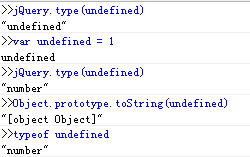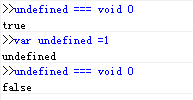JavaScript数据类型判定的总结介绍
用typeof 来检测数据类型
Javascript自带两套类型:基本数据类型(undefined,string,null,boolean,function,object)和对象类型。
但是如果尝试用typeof 来检测对象类型都一律返回"object"并不能加以区分
typeof null // "object" typeof [] // "object" typeof document.childNodes //"object" typeof /\d/ //"object" typeof new Number() //"object"
用constructor 属性来检测类型的构造函数
[].constructor === Array //true
document.childNodes === NodeList //true
/\d/.constructor === RegExp //true
function isRegExp(obj) {
return obj && typeof obj === "object" && obj.constructor === RegExp;
} //检测正则表达式对象
function isNull(obj){
return obj === null;
}
用construct检测可以完成大多数的类型检测,null特殊直接比较。然而iframe中的数组类型确无法检测出正确类型,这是用construct检测的一个缺陷;同时在旧版本IE下DOM和BOM的construct是无法访问的
利用 Object.prototype.toString 来判断
Object.prototype.toString.call([]) //"[object Array]" Object.prototype.toString.call(/\d/) // "[object RegExp]" Object.prototype.toString.call(1)//"[object Number]"
来看看jQuery源码中是如何使用toString方法的
/*
* jQuery JavaScript Library v1.11.2
*/
var class2type = {}; //用来保存js数据类型
jQuery.each("Boolean Number String Function Array Date RegExp Object Error".split(" "), function(i, name) {//构造class2type存储常用类型的映射关系,遍历基本类型并赋值,键值为 [object 类型]
class2type[ "[object " + name + "]" ] = name.toLowerCase();
});
type: function( obj ) {
if ( obj == null ) {//首先如果是null则返回null字符串
return obj + "";
}
//接着判断给定参数类型是否为object或者function,是的话在映射表中寻找 toString后的键值名称并返回,不是的话利用typeof就可以得到正确类型。
return typeof obj === "object" || typeof obj === "function" ?
class2type[ toString.call(obj) ] || "object" :
typeof obj;
},
/****************************/
jQuery.type(/\d/) //"regexp"
jQuery.type(new Number()) //"number"
这里能够使用toString方法来检测是因为不同对象都会重新定义自己的toString方法
说说一些特殊类型的检测

上述调试是在IE8中进行的,因为undefined 在javascript中并不是关键字,在IE8以下(之后的版本不可以赋值)是可以赋值的,查看jQuery.type源码可知,对于 undefined检测由是 typeof undefined完成的。jQuery.type并不能在旧的IE中检测出undefined的正确性。想要获得纯净的undefined可以使用 void 0

另外,对于DOM,BOM对象在旧的IE中使用Objec.prototype.toString检测出来的值均为 “[object Object]”

但是在chrome下的结果却完全不同(chrome可以检测出真实类型)

了解一下jQuery检测特殊类型
isWindow: function( obj ) {//ECMA规定window为全局对象global,且global.window === global
return obj != null && obj == obj.window;
},
isPlainObject: function( obj ) {
var key;
if ( !obj || jQuery.type(obj) !== "object" || obj.nodeType || jQuery.isWindow( obj ) ) {
return false;
}
try {//判断它最近的原形对象是否含有isPrototypeOf属性
if ( obj.constructor &&
!hasOwn.call(obj, "constructor") &&
!hasOwn.call(obj.constructor.prototype, "isPrototypeOf") ) {
return false;
}
} catch ( e ) {
return false;
}
if ( support.ownLast ) {
for ( key in obj ) {
return hasOwn.call( obj, key );
}
}
mass Framework相对jQuery中改善的地方
var class2type = {//将可能出现的类型都映射在了class2type对象中,从而减少isXXX函数
"[object HTMLDocument]": "Document",
"[object HTMLCollection]": "NodeList",
"[object StaticNodeList]": "NodeList",
"[object DOMWindow]": "Window",
"[object global]": "Window",
"null": "Null",
"NaN": "NaN",
"undefined": "Undefined"
};
type: function(obj, str) {
var result = class2type[(obj == null || obj !== obj) ? obj : serialize.call(obj)] || obj.nodeName || "#"; //serialize == class2type.toString
if (result.charAt(0) === "#") { //兼容旧式浏览器与处理个别情况,如window.opera
//利用IE678 window == document为true,document == window竟然为false的神奇特性
if (obj == obj.document && obj.document != obj) {//对DOM,BOM对象采用nodeType(单一)和item(节点集合)进行判断
result = "Window"; //返回构造器名字
} else if (obj.nodeType === 9) {
result = "Document"; //返回构造器名字
} else if (obj.callee) {
result = "Arguments"; //返回构造器名字
} else if (isFinite(obj.length) && obj.item) {
result = "NodeList"; //处理节点集合
} else {
result = serialize.call(obj).slice(8, -1);
}
}
if (str) {
return str === result;
}
return result;
}
类数组
类数组是一类特殊的数据类型存在,他们本身类似Array但是又不能使用Array的方法,他们有一个明显的特点就是含有length属性,而且 键值是以整数有序的排列的。这样的数组可以通过 Array.slice() 这样的方法转换成真正的数组,从而使用Array提供的方法。
常见类数组:arguments,document.forms,document.getElementsByClassName(等一些列节点集合NodeList,HTMLCollection),或者是一些特殊对象,如下所示:
var arrayLike={
0:"a",
1:"b",
2:"c",
length:3
}
通常情况下通过Array.slice.call既可以转换类数组,但是旧IE的HTMLCollection,NodeList不是Object 的子类,不能使用该方法,这时候需要构建一个空数组,然后将遍历节点push就如空数组中,返回新生成的数组即可,同时要区别出window 和 string对象,因为这类的对象同样含有length>=0(length不可被修改),但是不是类数组。
jQuery如何处理类数组的
makeArray: function( arr, results ) {
var ret = results || [];
if ( arr != null ) {
if ( isArraylike( Object(arr) ) ) {
jQuery.merge( ret,
typeof arr === "string" ?
[ arr ] : arr
); //jQuery.merge 合并数组 ,若是字符串则封装成数组河滨,不是则世界合并
} else {
push.call( ret, arr );
}
}
return ret;
}
Ext.js是如何处理类数组的
toArray: function(iterable, start, end) {
if (!iterable || !iterable.length) {
return []; //非类数组类型直接返回[]
}
if (typeof iterable === 'string') {
iterable = iterable.split(''); //分解字符串
}
if (supportsSliceOnNodeList) {
return slice.call(iterable, start || 0, end || iterable.length); //对于NodeList支持
}
var array = [],
i;
start = start || 0;
end = end ? ((end < 0) ? iterable.length + end : end) : iterable.length;
for (i = start; i < end; i++) {
array.push(iterable[i]);
}
return array;
}
mass Framework.js是如何处理类数组的
slice: W3C ? function(nodes, start, end) { //var W3C = DOC.dispatchEvent; IE9开始支持W3C的事件模型
return factorys.slice.call(nodes, start, end);
} : function(nodes, start, end) {
var ret = [],
n = nodes.length;
if (end === void 0 || typeof end === "number" && isFinite(end)) {
start = parseInt(start, 10) || 0;
end = end == void 0 ? n : parseInt(end, 10);
if (start < 0) {
start += n;
}
if (end > n) {
end = n;
}
if (end < 0) {
end += n;
}
for (var i = start; i < end; ++i) {
ret[i - start] = nodes[i];
}
}
return ret;
以上就是本文的全部内容,希望对大家的学习有所帮助
本文地址:http://www.45fan.com/bcdm/60434.html
